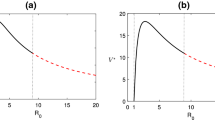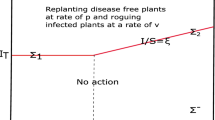Abstract
In this article, a mathematical model is formulated to study the dynamics of whitefly transmitted viral diseases in plants. Here, the aim is to capture the effect of whitefly’s age-stages on the disease dynamics. The existence of the equilibria, basic reproductive number (\({\mathcal {R}}_0\)), and stability have been studied through qualitative analysis. It is found that the onset of oscillations may occur through Hopf bifurcation in the system. Forward bifurcation is also observed at \({\mathcal {R}}_0=1\). Finally, optimal control theory has been applied for the cost-effectiveness of disease management.









Similar content being viewed by others
References
Al Basir F, Roy PK, Ray S (2017) Impact of roguing and insecticide spraying on mosaic disease in Jatropha curcas. Control Cybern 46(4):325–344
Al Basir F, Kyrychko YN, Blyuss KB, Ray S (2021) Effects of vector maturation time on the dynamics of cassava mosaic disease. Bull Math Biol 83(8):1–21
Arnó J, Gabarra R, Liu TX, Simmons AM, Gerling D (2009) Natural enemies of Bemisia tabaci: predators and parasitoids. Bemisia: bionomics and management of a global pest. Springer, Dordrecht, pp 385–421
Bailey NT (1975) The mathematical theory of infectious diseases and its applications. Charles Griffin & Company Ltd, Bucks
Byrne FJ, Oetting RD, Bethke JA, Green C, Chamberlin J (2010) Understanding the dynamics of neonicotinoid activity in the management of Bemisia tabaci whiteflies on poinsettias. Crop Prot 29(3):260–266
CAB International (2019a) Bemisia tabaci (MEAM1) (silverleaf whitefly). Invasive species compendium detailed coverage of invasive species threatening livelihoods and the environment worldwide. https://www.cabi.org/isc/datasheet/8927
CAB International (2019b) Bemisia tabaci (MED) (silverleaf whitefly). Invasive species compendium detailed coverage of invasive species threatening livelihoods and the environment worldwide. https://www.cabi.org/isc/datasheet/112682
De Barro PJ, Liu SS, Boykin LM, Dinsdale AB (2011) Bemisia tabaci: a statement of species status. Annu Rev Entomol 56:1–19
Faria M, Wraight SP (2001) Biological control of Bemisia tabaci with fungi. Crop Prot 20(9):767–778
Feng Y, Wu Q, Wang S, Chang X, Xie W, Xu B, Zhang Y (2010) Cross-resistance study and biochemical mechanisms of thiamethoxam resistance in B-biotype Bemisia tabaci (Hemiptera: Aleyrodidae). Pest Manage Sci 66(3):313–318
Fleming W, Rishel R (1975) Deterministic and stochastic optimal control, vol 1. Springer Verlag, New York
Fransen JJ (1994) Bemisia tabaci in the Netherlands; here to stay? Pest Sci 42(2):129–134
Gerling D, Horowitz AR, Baumgaertner J (1986) Autecology of Bemisia tabaci. Agric Ecosyst Environ 17(1–2):5–19
Gerling D, Alomar Ò, Arnò J (2001) Biological control of Bemisia tabaci using predators and parasitoids. Crop Prot 20(9):779–799
Hale JK, Lunel SV (1993) Introduction to functional differential equations. Springer-Verlag, New York
Heffernan JM, Smith RJ, Wahl LM (2005) Perspectives on the basic reproductive ratio. J R Soc Interface 2:281–293
Holt J, Jeger MJ, Thresh JM, Otim-Nape GW (1997) An epidemilogical model incorporating vector population dynamics applied to African cassava mosaic virus disease. J Appl Ecol 34:793–806
Horowitz AR, Ghanim M, Roditakis E, Nauen R, Ishaaya I (2020) Insecticide resistance and its management in Bemisia tabaci species. J Pest Sci 93:893–910
Jackson M, Chen-Charpentier BM (2018) A model of biological control of plant virus propagation with delays. J Comput Appl Math 330:855–865
Jeger MJ, Holt J, Van Den Bosch F, Madden LV (2004) Epidemiology of insect-transmitted plant viruses: modelling disease dynamics and control interventions. Physiol Entomol 29(3):291–304
Kedar SC, Saini RK, Kumaranag KM (2014) Biology of cotton whitefly, Bemisia tabaci (Hemiptera: Aleyrodidae) on cotton. J Entomol Res 38(2):135–139
Lacey LA, Wraight SP, Kirk AA (2008) Entomopathogenic fungi for control of Bemisia tabaci biotype B: foreign exploration, research and implementation. Classical biological control of Bemisia tabaci in the United States-a review of interagency research and implementation. Springer, Dordrecht, pp 33–69
Landahl HD, Hansen BD (1975) A three stage population model with cannibalism. Bull Math Biol 37(1):11–17
Ledder, (2017) Scaling for dynamical systems in biology. Bull Math Biol 79:2747–2772
Lefkovitch LP (1965) The study of population growth in organisms grouped by stages. Biometrics 1-18
Li S-J, Xue X, Ahmed MZ, Ren S-X, Du Y-Z, Wu J-H, Cuthbertson AGS, Qiu B-L (2011) Host plants and natural enemies of Bemisia tabaci (Hemiptera: Aleyrodidae) in China. Insect Sci 18(1):101–120
Liu S, Chen L, Agarwal R (2002) Recent progress on stage-structured population dynamics. Math Comput Model 36(11–13):1319–1360
MacDonald G (1955) The measurement of malaria transmission. Proc R Soc Med 48(4):295–302
Mahy BWJ, Van Regenmortel MHV (2008) Encyclopedia of virology, 3rd edn. Academic Press, Cambridge
M’Kendrick AG (1925) Applications of mathematics to medical problems. Proc Edinb Math Soc 44:98–130
Moreno-Ripoll R, Gabarra R, Symondson WOC, King RA, Agustí N (2014) Do the interactions among natural enemies compromise the biological control of the whitefly Bemisia tabaci? J Pest Sci 87(1):133–141
Mota-Sanchez D, Wise JC (2020) The arthropod pesticide resistance database. Michigan State University. http://www.pesticideresistance.org
Murray JD (2002) Mathematical biology. I. An introduction. Springer, New York
Naranjo SE, Ellsworth PC (2005) Mortality dynamics and population regulation in Bemisia tabaci. Entomol Exp Appl 116(2):93–108
Naranjo SE, Ellsworth PC (2009) The contribution of conservation biological control to integrated control of Bemisia tabaci in cotton. Biol Control 51(3):458–470
Naranjo SE, Castle SJ, De Barro PJ, Liu SS (2009) Population dynamics, demography, dispersal and spread of Bemisia tabaci. In: Stansly P, Naranjo S (eds) Bemisia: Bionomics and management of a global pest. Springer, Dordrecht, pp 185–226
Palumbo JC, Horowitz AR, Prabhaker N (2001) Insecticidal control and resistance management for Bemisia tabaci. Crop Prot 20(9):739–765
Roditakis E, Roditakis NE, Tsagkarakou A (2005) Insecticide resistance in Bemisia tabaci (Homoptera: Aleyrodidae) populations from Crete. Pest Manage Sci 61(6):577–582
Sani I, Ismail SI, Abdullah S, Jalinas J, Jamian S, Saad N (2020) A review of the biology and control of whitefly, Bemisia tabaci (Hemiptera: Aleyrodidae), with special reference to biological control using entomopathogenic fungi. Insects 11(9):619
Sharpe FR, Lotka AJ (1911) LA problem in age-distribution. Lond Edinb Dublin Philos Mag J Sci 21(124):435–438
Smith KM (1972) A textbook of plant virus diseases, 3rd edn. Elsevier, New York
Stansly PA, Sanchez PA, Rodrıguez JM, Canizares F, Nieto A, Leyva ML, Fajardo M, Suarez V, Urbaneja A (2004) Prospects for biological control of Bemisia tabaci (Homoptera, Aleyrodidae) in greenhouse tomatoes of southern Spain. Crop Prot 23(8):701–712
Van der Plank JE (1960) Analysis of epidemics. In: Horsfall JG, Cowling EB (eds) Plant pathology: an advance treatise. Academic Press, New York, pp 229–289
Van der Plank JE (1963) Plant diseases: epidemics and control. Academic Press, London
Venturino E, Roy PK, Al Basir F, Datta A (2016) A model for the control of the mosaic virus disease in Jatropha curcas plantations. Energy Ecol Environ 1(6):360–369
Acknowledgements
Sagar Adhurya acknowledges the University Grant Commission, Government of India for funding this research under NET-JRF scheme Sl no. 2061530673.
Author information
Authors and Affiliations
Corresponding author
Ethics declarations
Conflict of interest
The authors declare that no conflict of interest that could have influenced the work reported in this paper.
Additional information
Communicated by Juan Carlos Cortes.
Publisher's Note
Springer Nature remains neutral with regard to jurisdictional claims in published maps and institutional affiliations.
Appendices
Appendix A: Proof of part (iii) of Theorem 1
To prove the theorem, we use the following normal form representing of the system on the central manifold
where
and
In (26) and (27), \(\phi \) is a bifurcation parameter to be chosen, \(\phi _0\) is the critical vale; \(f_k\) denotes the right hand side of system (3), \(\mathbf{x}\) denotes the state vector, \(\mathbf{x}_0\) the disease-free equilibrium and \(\mathbf{v}\) and \(\mathbf{w}\) denote, respectively, the left and right eigenvectors corresponding to the null eigenvalue of the Jacobian matrix of a system, evaluated at the critical point.
Now, the system (3) is assumed at \({\mathcal {R}}_0=1\) that is \(\varLambda b =a\). Any of the parameters in the expression of \({\mathcal {R}}_0\) can be assumed as the bifurcation parameter. At the steady state \(E_0\), two eigenvalues of the characteristic equation are \(-\rho <0\) and \(-\mu <0\), and the remaining roots satisfy the cubic equation (14), that is, for \({\mathcal {R}}_0=1\), one eigenvalue is zero and other two satisfy
whose roots are real negative quantities. Thus, for \({\mathcal {R}}_0=1\) the disease-free equilibrium \(E_0\) is a non-hyperbolic equilibrium.
The right eigenvectors w = \((w_1,w_2, w_3,w_4,w_5)^T\) satisfies \(A(E_0)\mathbf{w }=0\), that is
This gives \(\mathbf{w }=(-1-a, ~1, ~0, ~ -b,~a)^T\). Again, the left eigenvectors z = \((z_1, z_2, z_3,z_4,z_5)^T\) satisfy \(A(E_0,\varLambda _0)^T\mathbf{v} = 0\), this yields z = \((0, ~1,~0,~0~\rho )^T.\)
The coefficients \(L_1\) and \(L_2\) is now computed using (26) and (27). Considering the system (3) and considering only the non-zero components of the left eigenvector \(\mathbf{z}\), it follows that:
and thus the bifurcation is forward.
Appendix B: Proof of Theorem 2
Proof
The characteristic equation at the endemic equilibrium \(E^*\) is
If the roots of the characteristic equation (28) have negative real parts, then \(E^*\) is stable. Applying the Routh–Hurwitz criterion (Murray 2002) on the coefficients of (28), we can say that the (28) has roots with negative real parts if the following conditions are satisfied:
Now, we discuss the existence of Hopf bifurcation.
Using the conditions (15), the characteristic equation (28) can be rewritten as follows
Thus two roots of this equation are
and the remaining two roots, \(\xi _3\) and \(\xi _4\) satisfy the equation
Using (29) and applying Routh–Hurwitz criterion (Murray 2002), we can say that they both have negative real parts.
To verify the transversality condition, we first note that \(\varPhi (\zeta ^*)\) is a continuous function of its argument, and hence, there exists an open interval \(\zeta \in (\zeta ^*-\epsilon ,\zeta ^*+\epsilon )\), where \(\xi _1\) and \(\xi _2\) are complex conjugate roots of the characteristic equation, which can be written as
with \(\xi _{1,2}(\zeta ^*)=\pm i\omega _0\).
Substituting \(\xi _j (\zeta ) =\zeta (\zeta )\pm i\nu (\zeta )\) into the characteristic equation (28), differentiating with respect to \(\zeta \), and separating real and imaginary parts gives
where
Solving the (31) for \(\zeta '(\zeta ^*)\) and using the condition in (15) we have
Therefore, the transversality condition is satisfies. This confirms the occurrence of Hopf bifurcation at the critical value \(\zeta =\zeta ^*\). \(\square \)
Rights and permissions
About this article
Cite this article
Adhurya, S., Basir, F.A. & Ray, S. Stage-structure model for the dynamics of whitefly transmitted plant viral disease: an optimal control approach. Comp. Appl. Math. 41, 154 (2022). https://doi.org/10.1007/s40314-022-01864-9
Received:
Revised:
Accepted:
Published:
DOI: https://doi.org/10.1007/s40314-022-01864-9
Keywords
- Mathematical model
- Basic reproduction ratio
- Bemisia
- Forward and Hopf bifurcation
- Optimal control
- Numerical simulation




